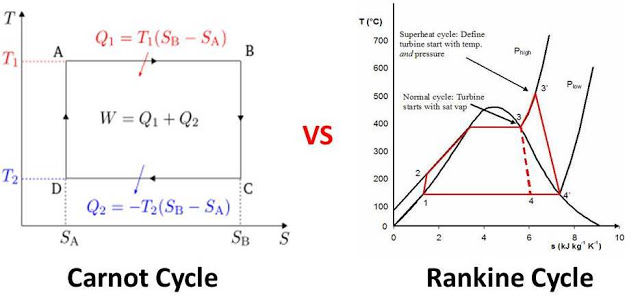Today I am going to tell you difference between Carnot cycle and Rankine cycle. Both Carnot cycle and Rankine cycle are air standard cycles. Carnot cycle is an ideal cycle for heat engine which gives highest efficiency between given temperature difference but it is a theoretical cycle and actually no engine works on it. Rankine cycle is an ideal cycle of vapor or steam power generation. All steam power plant work on this cycle. It use water as the working substance. Both these cycles have different features which I will describe below.
Carnot cycle has two isothermal processes and two isentropic processes. Heat is added and rejected isothermally and compression and expansion take place at constant entropy. It is a theoretical cycle because actually it is difficult to achieve isothermal heat addition and rejection. It gives highest efficiency between given temperature difference. As I told Rankine cycle is an ideal vapor power generation cycle used in steam turbine. It consist two isobaric and two isentropic processes. Heat is added and rejected at constant pressure and expansion and compression of steam takes place isentropically. In practically, first water is pumped to a boiler where heat is added at constant pressure which converts water into steam. This high temperature steam rotates the turbine. This expansion of steam takes places isentropically. Now the heat is rejected into condenser at constant pressure which converts it into water. Now this water is again pumped into boiler isentropically which complete the cycle. This cycle runs continuously which generate power.
The basic and main difference between Carnot and Rankine cycle is that in Carnot cycle heat is added and rejected at constant temperature and in Rankine cycle heat addition and rejection take place at constant pressure. The other main difference is that the Rankine cycle use water as working substance and Carnot cycle use air as working substance. There are many other differences which are describe below in tabular form.
Difference between Carnot Cycle and Rankine cycle:
|
Sr. No.
|
Carnot Cycle
|
Rankine Cycle
|
|
1.
|
It is a theoretical cycle. . It gives maximum efficiency between two temperature difference
|
This one is a practical cycle of steam engine and turbine.
|
|
2.
|
Heat is added and rejected at constant temperature.
|
Heat is added and rejected at constant pressure.
|
|
3.
|
It has highest efficiency between two temperature differences.
|
Rankine cycle has lower efficiency than Carnot cycle.
|
|
4.
|
Carnot cycle uses air as the working substance.
|
Rankine cycle uses water as working substance.
|
|
5.
|
Carnot cycle is an ideal cycle for heat engine.
|
It is an ideal cycle for vapor power engine.
|
Today we have discussed about main difference between Carnot cycle and Rankine Cycle. If you have any query regarding this article, ask by commenting. If you know any other differences, let us know through commenting. Thanks for reading it.


Why shouldn’t we use carnot cycle in place of rankine cycle as carnot has more efficiency???
Can you read. It is theoretical
Since it’s theoretical why should it be study
because adding heat at constant temperature is not practically possible due to system limitations , likewise the same in the case of Heat rejection ,
so when you try to use Carnot principle then you implement some of things on it and then it is practically possible and that modified system in Rankine cycle
What is the essence of studying it since it can’t be practicalize?
Studying the ideal cycle creates a standard that all power cycles aim to achieve. It is important to study the carnot cycle to adapt whatever cycle you work with to be as efficient as possible.
So for the rankine cycle, there are modifications like superheating, reheating, and regeneration (or a combination of them) which all improves the efficiency of the cycle.
Aren’t isothermal processes in Carnot cycle also isobaric?
no , just because of ideal gas equation pv = nrt